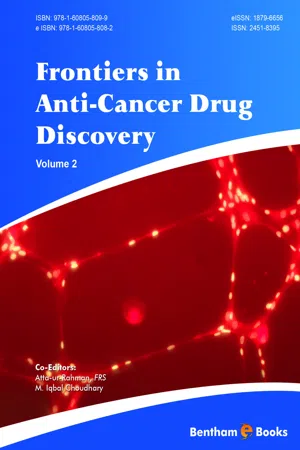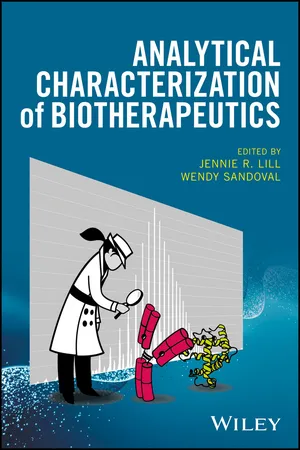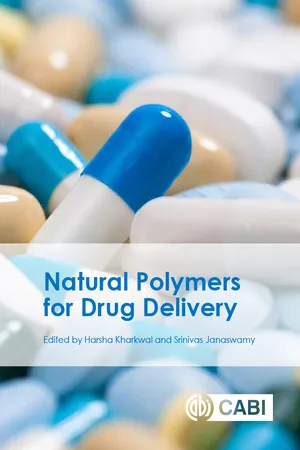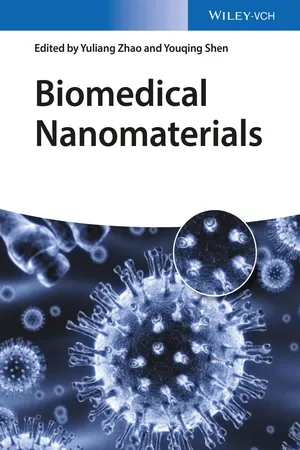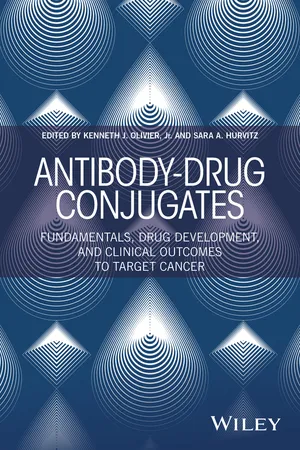Biological Sciences
Antibody Drug Conjugate
An Antibody Drug Conjugate (ADC) is a type of targeted cancer therapy that combines an antibody with a cytotoxic drug. The antibody specifically targets cancer cells, delivering the drug directly to the tumor cells while minimizing damage to healthy cells. This approach can enhance the effectiveness of chemotherapy and reduce side effects.
Written by Perlego with AI-assistance
Related key terms
6 Key excerpts on "Antibody Drug Conjugate"
- Atta-ur-Rahman, M. Iqbal Choudhary(Authors)
- 0(Publication Date)
- Bentham Science Publishers(Publisher)
Antibody-Drug Conjugates as Therapeutic Agents in Oncology: Overview And Perspectives Milos Dokmanovic , Mohammed K. ElZarrad , Dianne S. Hirsch ,Wen J. Wu*Laboratory of Molecular Oncology, Division of Monoclonal Antibodies, Office of Biotechnology Products, Office of Pharmaceutical Science, Center for Drug Evaluation and Research, U.S. Food and Drug Administration, Bethesda, Maryland, USAAbstract
Antibody-drug conjugates (ADCs) are an emerging class of therapeutics that are generated by covalent attachment of cytotoxic agents to monoclonal antibodies via linkers. It is generally believed that following antibody binding to the antigen and ADC internalization, release of toxic payload would produce cytotoxic effects in tumor cells in relatively selective manner. The clinical development of ADCs was not feasible until several critical prior developments took place, including development of recombinant therapeutic monoclonal antibody production, advancement of linker technology, and discovery of potent cytotoxic agents.In this book chapter, we will briefly introduce the history of ADC development and focus on the development and mechanisms of action of ADCs in oncological indications. In addition to covering present ADC therapies in clinical trials we will also offer possible future directions for ADC therapies, such as development of antibodies against new therapeutic targets, use of novel antibody and non-antibody-based platforms for the ADC development, use of novel linker designs for ADC generation, as well as development of novel payloads for antibody-based conjugates. As these development trends continue, future potential of ADC therapies to address the needs in oncology indications will be explored. Note that the information presented in this article represents publically available information. Any opinions expressed reflect the views of the authors and do not represent the policy of the U.S. Food and Drug Administration.- eBook - ePub
- Jennie R. Lill, Wendy Sandoval(Authors)
- 2017(Publication Date)
- Wiley(Publisher)
7 Characterization of Antibody–Drug ConjugatesYichin LiuDepartment of Biochemical and Cellular Pharmacology, Genentech Inc., South San Francisco, CA, USAAbbreviations
ADC antibody–drug conjugate CCS collision cross section DAR drug‐to‐antibody ratio HCD higher‐energy collisional dissociation HDX hydrogen–deuterium exchange HIC hydrophobic interaction chromatography IM‐MS ion mobility mass spectrometry LC‐MS liquid chromatography mass spectrometry MGBA minor groove‐binding alkylating MS mass spectrometry nano‐ESI nanoelectrospray ionization NHSN‐hydroxysuccinimideTMT tandem mass tag TOF time‐of‐flight TWIM‐MS traveling wave ion mobility MS VC‐PABCvaline‐citrulline‐p‐aminobenzylcarbamateWT wild type7.1 Introduction
Target‐specific antibodies armed with potent cytotoxic agents to form antibody–drug conjugates (ADCs) have shown promise as novel therapeutic agents in fighting human cancer. An ADC consists of three major components: antibody, linker (either cleavable or noncleavable), and cytotoxic payload. The rationale behind using ADCs is to bring specificity of a cytotoxic agent by coupling it to an antibody that selectively targets tumor cells with the goal of enhancing the therapeutic index (TI), the window between maximal tolerated dose (MTD) and minimal efficacious dose (MED). In principle the TI should be greatly enhanced for ADCs compared to the direct treatment with the cytotoxic agent, which brings damage to normal cells and tissues. However, in practice, ADCs have not lived up to the initial promise of complete tumor specificity. The limited success of ADCs is due to numerous challenges in designing a molecule that selectively releases its toxic payload only in the tumor environment while sparing normal tissues. These challenges include (i) identifying appropriate tumor antigens and their respective epitopes to trigger efficient internalization of ADC to the lysosomal compartment for degradation and (ii) designing an effective intracellular payload release mechanism in tumor cells while maintaining its stability in circulation. - eBook - ePub
- Harsha Kharkwal, Srinivas Janaswamy(Authors)
- 2016(Publication Date)
- CAB International(Publisher)
2013 ).Protein–Drug Conjugates/ Antibody–Drug Conjugates
Historical background
The phenomenon of ADCs was introduced in 1956 by the German scientist Paul Ehrich, who invented the concept of selective targeting of tumour cells through antibodies and delivering the cytotoxic drugs to those particular tumour cells (Ehrlich, 1956 ). He used the term ‘magic bullet’ to describe the idea, but it took nearly 50 years for it to actually take shape and to produce the first ADCs (Trail, 2013 ). MTX was linked with the antibody 791T/36 to target leukaemia cells (Affleck and Embleton, 1992 ). Prior to this invention, polyclonal antibodies were being used as the targeting agents but the emergence of ADCs has altered the market scenario and certainly aided in their advancement. Since 1990, a high number of drugs have been approved by the FDA and in the year 2012 alone, 39 drugs were approved. Market analysts predict that up to 2016, the number of approvals could be around 35 drugs per year (Berggren et al., 2012 ; Kitson et al., 2013 ).The immunotherapeutic use of target-based antibody–drug conjugates may be the next major drug discovery in cancer treatment (Fig. 9.3 ). The idea behind PDCs is to avoid harm to the normal cells and to eliminate the tumour cells effectively. Individually, cytotoxic drugs are very harmful to cells, but the toxicity is manageable when combined with a targeted antibody. The linkage between cytotoxic drug and antibody is stable, but chemical or linker dependent (explained later in the chapter), and goes directly to the targeted tumour cells and releases the drug within them (Kovtun and Goldmacher, 2007 ). The first ADC was produced by the pharmaceutical company Wyeth with the trade name Mylotarg (gemtuzumab ozogamicin), for the treatment of acute myelogenous leukaemia. However, it was withdrawn from the market due to the inefficiency in maintaining the survival rate (Reichert, 2013 ). In 2011 the FDA approved another drug, brentuximab vedotin (Adcetris), a chimeric monoclonal antibody, for the treatment of Hodgkin’s and anaplastic large cell lymphoma. This was one of the initial ADCs in which the antibody target cell membrane protein C30 was linked with the drug (cathepsin) through a cleavable linker (valine–citrulline) (Lambert, 2013 ; Sievers and Senter, 2013 ). In 2013 ado-trastuzumab emtansine (Kadcyla; Genentech/Roche) medication for late-stage HER2-positive breast cancer was approved by the FDA. In this medication, trastuzumab was combined with the maytansinoid DM1 via a linker nonreducible thioether (Phillips et al., 2008 ). Currently more than 100 clinical trials are in the pipeline for the validation of several ADCs for cancer treatment (Table 9.1 and 9.4 ; Mullard, 2013 - eBook - ePub
- Yuliang Zhao, Youqing Shen(Authors)
- 2016(Publication Date)
- Wiley-VCH(Publisher)
On the basis of the success of ADCs, many researchers in both academia and industry are seeking for new modalities. Besides the optimization of every part of current ADCs, some existing innate paradigms may need to change. Some enthusiastic start-ups are at the forefront of new paradigm development.For instance, Mersana Therapeutics designed a type of new linker system named Fleximer, which is a highly hydrophilic, biodegradable derivative of polysaccharide [134]. Its superiority lies in the fact that dozens of small-molecule drugs can be linked to an antibody through this linker to increase DARs without compromising the antibody's activity and pharmacokinetic properties. In this way, the drug payloads do not have to possess high potency, because the number of drugs can totally make up for the deficiency in potency. Of course, this new modality needs to be further proved in clinical trial.Centrose developed an extracellular drug conjugate (EDC) system [135]. The components of EDCs are similar to those of ADCs, including a targeting part (like an antibody), drug, and linker, which connects the former two together. However, EDCs do not need internalization into cells, which is always a barrier for ADCs, because the drugs used in EDC system function outside of cells by stimulating downstream signal pathway to induce cell death. In addition, since EDCs cannot be degraded, the drugs would not be released from the system. This characteristic reduces off-target toxicity, which is a concern of ADCs.Besides small-molecule drugs, many other molecules can be used as payloads. For example, replacement of drugs with radionuclides results in antibody radionuclide conjugates, which can be used for imaging and therapy [136, 137]. Furthermore, antibody–RNA conjugates [138], antibody–antibiotic conjugates [139], antibody–protein conjugates [140], and antibody–fluorophore conjugates [141] are constantly emerging and have wide applications in biomedicine.References
- 1. Ferlay, J., Shin, H.R., Bray, F. et al. (2010) Estimates of worldwide burden of cancer in 2008: GLOBOCAN 2008. Int. J. Cancer, 127
- eBook - ePub
Antibody-Drug Conjugates
Fundamentals, Drug Development, and Clinical Outcomes to Target Cancer
- Kenneth J. Olivier, Sara A. Hurvitz(Authors)
- 2016(Publication Date)
- Wiley(Publisher)
In an attempt to increase antitumor activity of anticancer drugs, oncologists have evaluated several families of highly cytotoxic agents such as the potent tubulin-acting agents, maytansine and dolastatin 10, and highly active DNA-acting agents such as the duocarmycins (adozelesin, bizelesin). Unfortunately, clinical evaluation of such potent compounds failed to show any clinical benefit; such compounds lacked a sufficient therapeutic window to be useful in cancer treatment (see e.g., [73]). However, with the advent of nonimmunogenic monoclonal antibodies (engineered antibodies, or derived from transgenic organisms expressing human immunoglobulin genes), medicinal chemists had the possibility of being able to harness the great potency of these cytotoxic compounds by using the potential tumor selectivity of antibodies as vehicles to concentrate them at the tumor. The proof of concept for this approach has been achieved with the approval of two ADCs bearing highly potent tubulin-acting agents, brentuximab vedotin, which received accelerated approval by FDA in 2011 for treating Hodgkin’s lymphoma and acute large-cell lymphoma [51], and ado-trastuzumab emtansine that received full approval from FDA in 2013 for treating metastatic HER2-positive breast cancer [26, 74]. These approvals have re-invigorated research into ADCs within academic institutions as well as in the biopharmaceutical industry. With over 50 compounds in clinical testing at the time of writing, the prospects are exciting for ADCs to make a significant contribution to improving the therapeutic options for cancer patients, offering agents that have excellent antitumor activity while lacking the severe toxicities that are frequently associated with cytotoxic chemotherapy.Acknowledgment
I wish to thank Dr Daniel Tavares for providing excellent illustrations of antibodies and ADCs and Dr Ravi Chari and Dr Wayne Widdison for their skilled drawing of chemical structures for linkers and payloads. I thank C Bennett for skilled editorial review. I wish to dedicate this chapter in memory of my mentor (and Ph.D. supervisor), Dr Richard N. Perham. - eBook - ePub
- Matzku(Author)
- 2019(Publication Date)
- CRC Press(Publisher)
et al., 1989).Figure 1 Molecular organization of an antibody-doxorubicin conjugate containing an acid sensitive hydrazone linker (arrow) and a stable thioether bond.Table 3 Clinical trials of cancer therapy with antibody-drug conjugatesCHEMICAL IMMUNOTOXINS
An immunotoxin is a macromolecular complex composed of an antibody and an enzymatically active toxin of plant or bacterial origin. Due to their protein nature antibodies and toxins can be linked either chemically using cross-linking reagents or by fusion of their genes to produce single-chain fusion toxins. Whereas the antibody moiety directs the immunotoxin to antigens on the cell surface, the toxin arrests protein synthesis in eukaryotic cells in an irreversible manner. Since this mechanism of action greatly differs from that exerted by conventional chemotherapeutic drugs immunotoxins might prove particularly promising for the treatment of cancers resistant to chemotherapy. Due to the high potency of toxins, a major concern of immunotoxin therapy is that the toxin must be harnessed using a carefully selected targeting system to limit unwanted side effects in patients. In comparison to their recombinant counterparts, chemical immunotoxins are heterogeneous with respect to the number of linkers and the sites of amino acid side chain substitutions introduced into the antibody. Consequently, chemical immunotoxins consist of mixtures of unconjugated, singly- or multiply-substituted antibodies, and further structural heterogeneity of chemical immunotoxins is caused by the attachment of toxins to different sites of the antibodies. Nevertheless, owing to improved protein modification, cross-linking, and purification techniques highly selective and potent immunotoxins can be prepared directly from natural sources and in quantities sufficient for human therapy. Chemical immunotoxins are usually larger in size than recombinant immunotoxins and therefore penetrate solid tumors less efficiently. On the other hand, their longer half-life in the circulation may increase the total dose that localizes to the tumor and is of advantage for the treatment of hematopoietic malignancies.
Learn about this page
Index pages curate the most relevant extracts from our library of academic textbooks. They’ve been created using an in-house natural language model (NLM), each adding context and meaning to key research topics.
